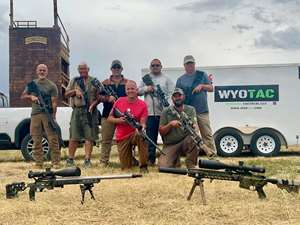Long Range Precision Rifle 3 Day
Intermediate
Duration: Approx. 4 Hours Classroom and 20 Hours Range Time
Environment: In Person
$800.00
Fee
| Date | Availability |
|---|
There are no upcoming classes scheduled for this course.
Description
This course is designed around building the shooter, and is not weapon system dependant. Whether you are shooting a bolt, or gas gun and irregardless of caliber, this course will have you shooting confidently to you, and your rifles maximum potential.
Round count for this class is 300 rounds*
We recommend Match Grade ammunition that is tested in your rifle.
Our Targets range from 1/4 to 2 MOA

Topics Covered
Rifle and Optic functionality and calibration
Developing D.O.P.E. for your Rifle
Understanding and reading Environmentals and how they affect bullet flight path
Reading Trace and calling follow up shots
Shooter / Spotter Communications
Ranging Targets using your Scope Reticle
Firing Positions / Observation
Target Indicators / Target Location

Expectations and Outcomes
Certificates are issued at the end of Class.
Students will be able to acheive first round hits on a high percentage of targets from 400 - 1000 yards distances
Understand environmental factors
Have a solid D.O.P.E. for thier rifle
Have a solid understanding of ballistics and their equipment

Types
Advanced, Intermediate, Benchrest, LEO / MIL / SEC Courses, Long Range Precision, PRS / NRL (Precision Rifle Competition), Rifle, Specialty Other

Documentation Requirements
The instructor requires a copy of your Government Issued ID once you register.

Requirements
Rifle:
Rifle capable of 1 MOA accuracy with the ammunition used in class. Rifles need to be rugged, reliable and easily portable. Calibers should be .308 Win or similar. Other full size cartridges such as 6.5 Creedmore, .243 or even 30-06 are acceptable, but match grade ammunition can be difficult to find and may be a hand load proposition only. Heavy magnum calibers are prohibited due to the damage inflicted on the targets. They are also not favorable to the training environment due to the heavy recoil. A bipod, while not essential, will make shooting from most positions much easier. Harris Bipods are probably the most prevalent on the market. They are dependable, and relatively inexpensive.
Rifle Scope:
Rifle Scopes must be suitable for long range precision. They should have target style turrets, well distinguished reticles metered in either MOA or MRAD measurements. Target knobs should be clearly marked and provide solid, consistent "clicks". Scopes also must have a usable magnification. Typically modern optics use a variable power in the 4x-16x, 6x-24x or 8x-32x ranges. All of these are suitable for our class. BDC reticles are frowned upon due to the fact that without calibrating to each individual rifle configuration and load developed specifically for that rifle, they are never exact. Scopes must be properly mounted to the rifle. Good quality scope rings and bases are a must. Scope rings should have a minimum of 4 screws per ring to ensure a secure mount.
Cleaning Equipment:
A basic cleaning kit is essential for keeping your firearm running smooth. Make sure that you have patches, solvents, lubricant and cleaning jags. A 1 piece cleaning rod is preferred.
Binoculars / Spotting Scope:
A set of pocket type compact binoculars in the 6x to 10x range will work well for the observation tasks. Full size 10×50’s are appropriate as well. A good spotting scope on a portable camera tripod is necessary when acting as spotter. With it, one can see impacts, read mirage and wind, plus identify suspected targets far better than through a riflescope. The most practical scope will be compact, armored, and waterproof and have a magnification between 12x to 40x. If you select a fixed power scope, stay in the 20x to 25x range, since mirage can be a serious problem at higher powers. A variable permits dialing up the best power for the conditions, but will generally be larger and heavier. If the spotting scope can be obtained with a MRAD or MOA reticle installed, you can use it to range and call corrections to the shooter much more accurately.
Pack:
Having a good pack is essential for carrying your equipment. We will be moving frequently to different ranges and shooting positions. Make sure your pack is rugged, and keeps your equipment well organized.
Misc.:
A small pocket calculator
Rear Bag / Sand Bag These can either be made or purchased. Tab Gear, Armageddon Gear or FEHU Outdoors are your best sources for shooting bags.
Shooting Mat. This can be as simple as a piece of canvas, but having a mat to shoot from while prone will be more comfortable and help keep your equipment cleaner.
Camelbak or similar water carrier. We will be in the field for extended periods, having a way to carry water is essential. Your eyes are the first thing to suffer the effects of dehydration.
Ammunition carriers, a small camera, knee pads, sunscreen and bug spray are all things to consider.



